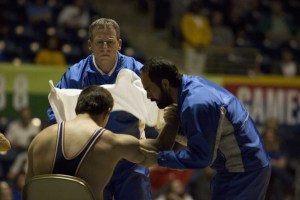
“Shooting for the stars,” is how production designer Jess Gonchor describes his efforts on Bennett Miller‘s Foxcatcher. Best known for his work in No Country for Old Men (2007), Moneyball (2011) and True Grit (2010), which earned him an Academy Award nomination, Gonchor was fascinated by the story of the strange relationship between millionaire John du Pont (Steve Carell) and wrestler Mark Schultz (Channing Tatum). This film is the third collaboration between Gonchor and Miller. The director gave Gonchor his start years ago when he hired him to work on a commercial.
Foxcatcher opens in Wisconsin and from there the story travels through several worlds. Gonchor worked to contrast the rich, wealthy world on the du Pont estate, and the working-class world of wrestler Mark Schultz. There were many contrasts to be made in telling this story and the color palette helped create definition. The color palette throughout the film is mostly bleak and monochromatic. But it peaks at important times. Gonchor’s favorite scene is when the wrestler first walks into the Foxcatcher gym. The production designer pursued a color palette in this scene that evokes “Christmas morning, when you go downstairs and all these brightly wrapped presents are around the tree. You walk in with the yellow and red wrestling mats and bright blue walls,” said Gonchor. He created a color palette theme when it came to the wrestling matches. “Every time there was a wrestling scene, the colors peaked because there was a chance for greatness there,” he explained.

The wrestling venue scenes were giant undertakings to set up. “We had to build these giant wrestling venues – never mind the signage – and fill the entire size of a hockey rink with all the period wrestling mats and weigh stages and interesting shapes in there,” Gonchor said. He had to create the wrestling venues in a very short period of time because the budget limited the amount of time he could rent all the things that filled the set.
Another difficulty was in creating the du Pont mansion, which was actually shot from four different places. “The exterior was one place, and there were two other mansions that we shot at, and we also built some of the rooms. So making it look like one mansion and tying it all together so it was believable as one place was a challenge.” The seamless arrangement and consistency in the design of the du Pont mansion, as trying as it was, also produced one of Gonchor’s favorite sets: John du Pont’s office. “We wanted it to seem like he wanted it to be like the Oval Office, a commander in chief type of thing.”
Shooting for the stars worked out brilliantly for Gonchor and this film. “We try to get really close, and sometimes succeed as well,” Gonchor said.





